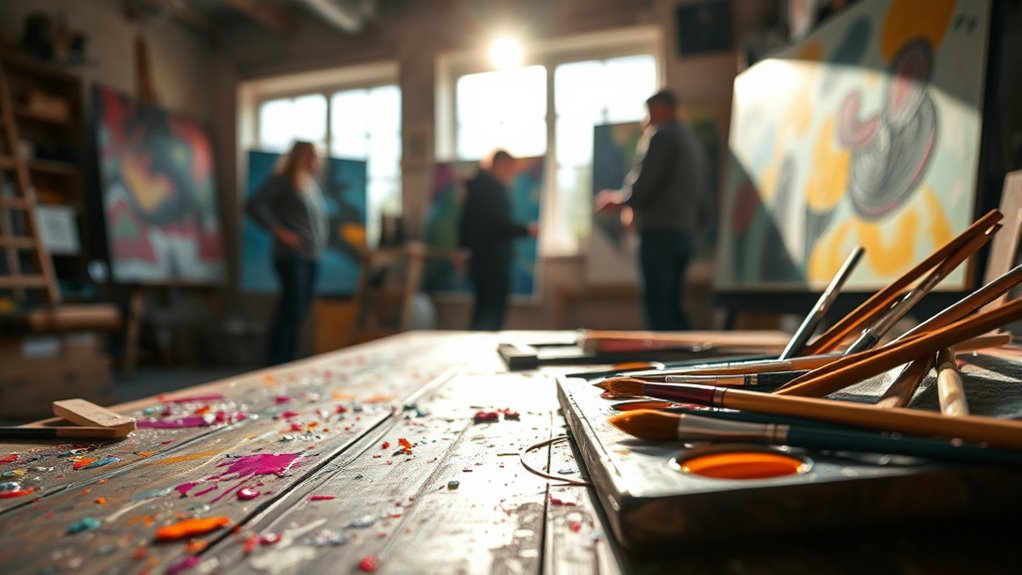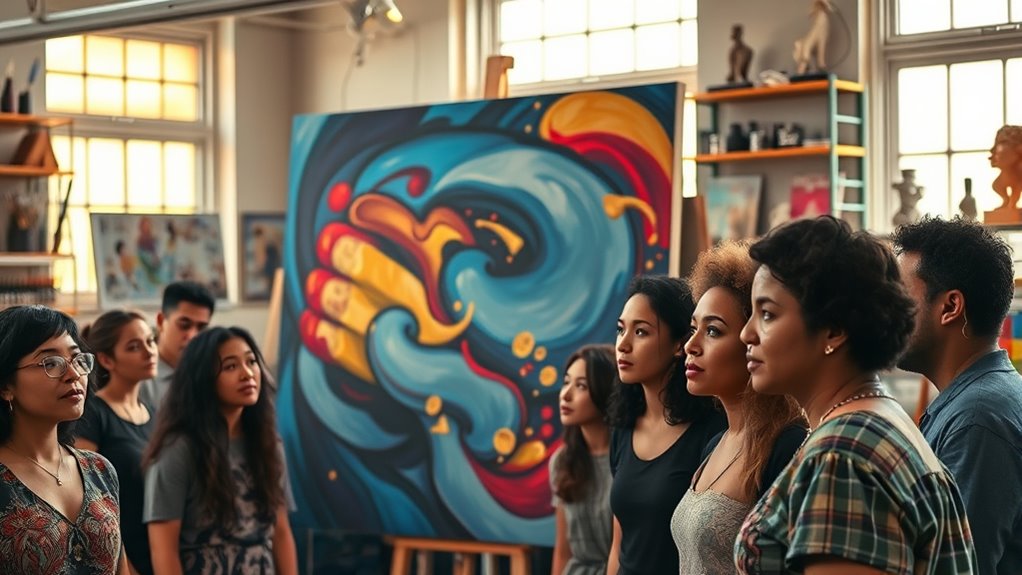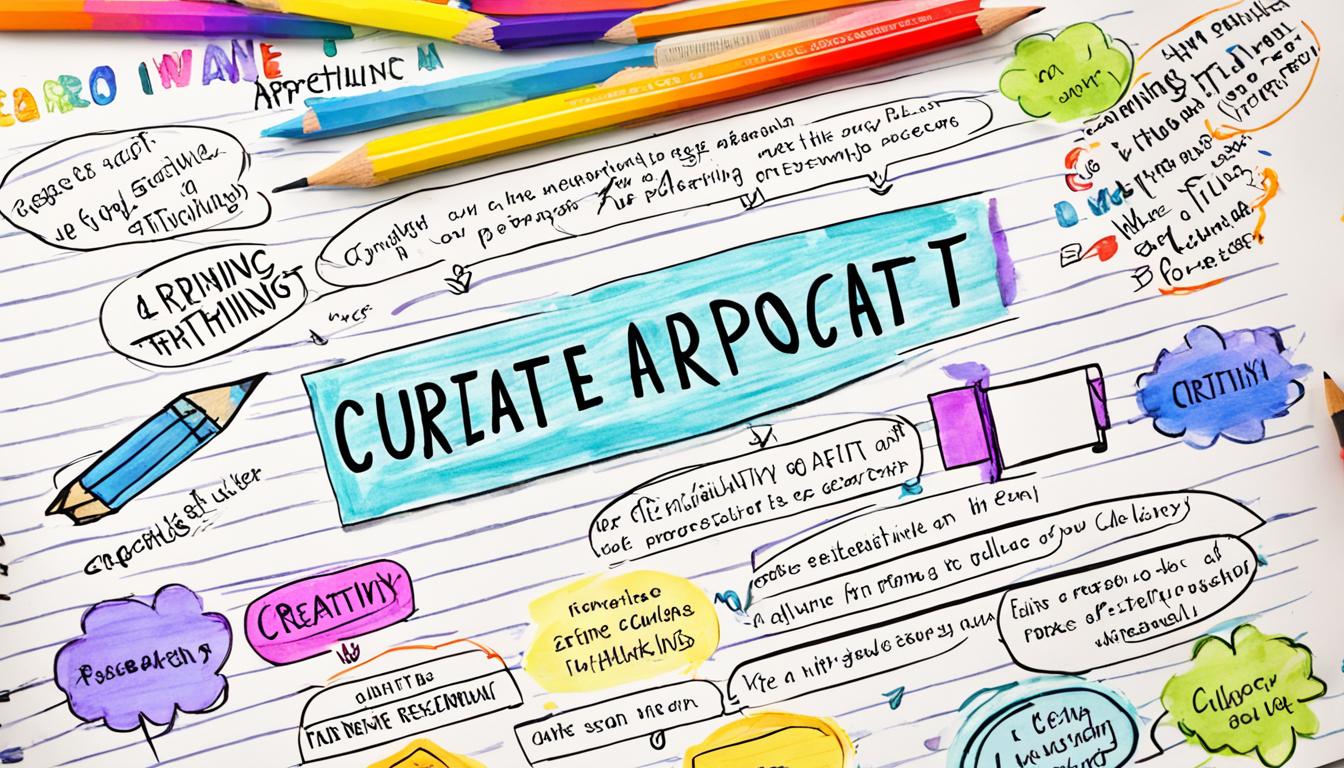Your perception and response to art involve complex psychological processes that connect visual cues to your personal memories, cultural background, and natural preferences. As you engage with an artwork, your brain searches for significance, triggering emotions based on familiar symbols or patterns. Your reactions are shaped by internal factors like subconscious memories and external influences such as context and mood. By exploring how your mind interprets art, you’ll discover deeper insights into your emotional connections and perceptions—if you keep exploring, you’ll uncover more.
Key Takeaways
- Art evokes emotional reactions by engaging visual elements, personal memories, and subconscious associations.
- Perception of art is influenced by individual cultural background, experiences, and innate preferences.
- The brain searches for significance in artworks, linking symbols to emotions, memories, or stories.
- Aesthetic judgments are shaped by internal factors like mood, expectations, and psychological history.
- Active engagement with art enhances emotional understanding and deepens psychological connection.

Have you ever wondered why certain artworks evoke strong emotions or resonate deeply within us? It’s because art taps into our emotional response and challenges our aesthetic evaluation. When you stand before a painting or sculpture, your brain processes more than just colors and shapes; it interprets symbols, stories, and feelings embedded within the work. This complex interaction forms the basis of your emotional response, shaping how you connect with art on a personal level. Your aesthetic judgment—how you evaluate beauty, meaning, or value—is influenced by a mix of personal experiences, cultural background, and innate preferences. These factors combine to create a unique lens through which you perceive art, making each encounter deeply subjective.
Your emotional response begins with the sensory input—what you see, hear, or feel from the artwork. But it quickly evolves as your mind searches for significance. For example, a vibrant, chaotic painting might evoke excitement or unrest, while a peaceful landscape could bring feelings of calm or nostalgia. Your brain automatically seeks out familiar patterns or symbols, often associating them with memories or emotions stored in your subconscious. This process explains why two people can view the same piece and have entirely different reactions. One may feel uplifted, while another might experience discomfort or indifference. It’s this variability that makes the psychology of art so fascinating: your personal history and emotional state heavily influence your response. Additionally, the visual elements of the artwork—such as composition, color, and texture—play a crucial role in shaping your perception and emotional reaction. Recognizing the psychological effects of different artistic styles can deepen your understanding of your own responses and those of others. Understanding how your perception is influenced by internal and external factors, including emotional responses, can help you approach art with greater awareness and insight. Furthermore, studies in IRA investment strategies show that engaging with art can also be a form of emotional investment, influencing your overall well-being and decision-making processes.
Our emotional reactions to art are shaped by subconscious memories and personal history.
Aesthetic judgment isn’t just about finding something beautiful; it involves an active evaluation of an artwork’s technical qualities, emotional impact, and contextual meaning. You might admire the brushstrokes in a masterpiece or feel moved by its underlying message. Your judgment is shaped by your expectations, cultural conditioning, and even your current mood. When you engage with art consciously, you’re often evaluating whether it resonates with your values or challenges your perspectives. This evaluative process can deepen your emotional response, enhancing the sense of connection or understanding. Ultimately, your aesthetic judgment guides how you interpret and appreciate art, but it’s also flexible—your perceptions can shift over time as you gain new experiences or insights.
Understanding this interplay between emotional response and aesthetic judgment reveals why art holds such power. It isn’t merely a visual experience; it’s an intricate dance between your inner world and external stimuli. Recognizing that your reactions are subjective yet rooted in psychological processes allows you to approach art with greater openness and curiosity. Every encounter becomes an opportunity to explore your emotions, challenge your judgments, and deepen your appreciation for creativity’s role in human experience.
Frequently Asked Questions
How Does Cultural Background Influence Art Perception?
Your cultural background shapes how you interpret art through cultural interpretation and symbolic meaning. It influences what you see as significant, beautiful, or meaningful, guiding your emotional response. Different cultures associate specific symbols and themes with unique meanings, so your perception of artwork varies based on your cultural lens. This personal framework helps you connect with art on a deeper level, making your experience uniquely yours.
Can Art Therapy Improve Mental Health Outcomes?
Imagine your mind as a garden, and art therapy as the gentle rain that helps it bloom. You can experience emotional healing and stress reduction through creative expression, which allows your inner world to surface and be understood. Engaging in art therapy provides a safe space to process feelings, reduce anxiety, and foster resilience, ultimately nurturing your mental health. It’s a colorful path to wellness that you can walk at your own pace.
What Neurological Processes Are Involved in Appreciating Art?
When you appreciate art, your brain activates neural pathways that handle visual processing and emotional response. Sensory integration occurs as your brain combines colors, shapes, and textures to create meaning. This process engages areas like the visual cortex and limbic system, which help you feel connected and stimulated. Your brain’s ability to integrate these sensory inputs allows you to experience art deeply, making appreciation a complex neurological activity.
How Does Age Affect Our Response to Different Art Forms?
Age shapes your response to art just as it influences your overall perception. While younger people might prefer vibrant, dynamic pieces, older adults often appreciate subtlety and depth. Your developmental perception evolves, making you more receptive to different art forms over time. Age-related preferences develop through life experiences, enriching your understanding and emotional connection, highlighting how your relationship with art deepens and shifts as you grow older.
Does Exposure to Art Enhance Creativity in Daily Life?
Exposure to art boosts your creative thinking by providing visual stimulation that sparks new ideas and perspectives. When you regularly engage with different art forms, you train your mind to see connections others might miss, enhancing your problem-solving skills. This daily interaction with art encourages your imagination to flourish, making it easier to apply creative approaches in everyday life, from work tasks to personal projects.
Conclusion
As you step back from the canvas, you realize that art isn’t just about colors or shapes; it’s about the emotions it stirs within you. Just like a whisper in a noisy room, a single brushstroke can evoke deep feelings amid chaos. Your perception transforms chaos into meaning, reminding you that art’s power lies in its ability to connect your inner world with the chaos of the outside.









